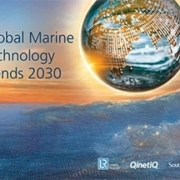Technology in Maritime: Eight Emerging Trends That You Need to Know for 2020
/in Ocean Industry /by johnFrom autonomous shipping to big data and analytics, here are eight maritime technologies you need to know for 2020 and beyond
The landscape of maritime is shifting with the rising tides of technology. The trends that are emerging are doing so out of necessity. Advances in shipbuilding, propulsion, smart shipping, advanced materials, big data and analytics, robotics, sensors and communications in conjunction with an increasingly skilled workforce are all having monumental shifts in how the maritime industry are approaching new challenges and opportunities.
The drivers for these technologies are balanced between environmental and commercial necessity. As a catalyst, environmental policies are fast tracking some of the developments to drive sustainability, and as a result have pushed for greater R&D and adoption of tech to reduce GHG emissions, and the benefits are clear. For example, hybrid propulsion has the potential to save 20-30% on vessel operating costs, all whilst reducing GHG emissions.
What Are the Future Technologies of Maritime?
Regulatory changes and compliance are having a profound impact on the maritime industry, this is for certain. But what technologies are the leaders investing in for a sustainable and viable future of maritime?
According to the Global Marine Technology Report 2030, two technology landscapes will shape the future of commercial shipping with a significant impact on ship design and ship operation: the first technology arena originates from within the industry, as intense competition encourages technology sophistication and operational efficiency in order to gain commercial advantages. The second technology area comes from other sectors, as maturing technology is ripe for transfer to ship system design and operation to enhance safety, as well as financial and commercial performance.
Shipbuilding
Design freedom, efficient customisation, waste reduction and managing virtual inventory will drive the development for future shipbuilding technologies.
Apart from the breakthrough in products’ operational efficiency, environmental impact is a major driver in adopting new shipbuilding technologies. For instance, 90% of raw materials may be in traditional subtractive manufacturing methods. By contrast, the introduction of additive manufacturing deposits materials only where they are required.
Ship propulsion and power generation will be a significant area of technological development. It is not only the scope of applicable technology, which includes future engines, alternative fuels, propulsion energy-saving devices, renewable sources of energy, hybrid power generation, and emissions abatement technology.
It is also, and perhaps more importantly, the scale of future environmental challenges for commercial shipping which makes propulsion and powering a key technological theme. Notably vessels are claiming 20% reducing in fuel costs with hybrid propulsion whilst significantly reducing emissions.
10% of the new buildings will be smart ships – arguably, smart ships are not a revolution but an evolution.
Today’s concept of unmanned machinery spaces may be considered another manifestation of the smart ship, as are data-driven services such as vessel performance monitoring and weather routeing – the modern smart ship will integrate a variety of connected technologies to improve operational efficiency, ship management, regulatory compliance, decision making, environmental responsibilities and also improve safety and maintenance of vessel and crew through communication networks.
IT infrastructure will be upgraded to retrieve, store, and process data in real time.
Archived data can be stored either onboard a ship or onshore, thanks to the support of communication technologies. Furthermore, cognitive systems will act as data interpreters for humankind. These systems will combine machine learning and natural language processing to offer an intuitive interface between a person and a machine.
Developing advanced materials for ship applications will be a critical component of improving future ship performance. New features will be introduced, and multi-functional materials can be created.
A new generation of machinery will emerge with enhanced performance. Inherent smart features can be designed for corresponding applications; these may include self-cleaning and self-repairing materials, which would have a myriad of benefits when it comes to safety and maintenance.
There are three new types of robots that will be in use by 2030. The first will be a learning robot, the second will be a practical robot (one that can handle an asset), and the third type will be a mini-robot, useful for inspections in harsh, dangerous environments. These robotics will leverage: cognition, versatility, imitation, sense and adaptability.
The development of these types of robots is very closely linked to the development of other technologies, like sensors and remote controls. These solutions require system response times (including network delays) of less than a few milliseconds.
The utilisation of sensors will represent a powerful opportunity for improvements in the efficiency and safety of vessels and associated equipment’s. Sensors and the data they generate will have enormous potential within the commercial shipping sector. Real-time monitoring and analysis strategies will be the key to improving the commercial shipping sector.
The capture of vessels’ top-quality data by means of robust and reliable sensors will open up new ways of optimising vessels’ life cycles. One outcome will be to make possible the ability to extend the life cycle of a vessel following top-standard operational criteria. This technology will provide data which will need to be properly transferred, stored and analysed.
Today, ships generate, collect and transmit an ever-increasing volume of data. To achieve efficient data transfer, wireless communications have been widely adopted for many years. Marine very high frequency (VHF) installations, satellites and WiFi are just a few examples. Using a higher frequency band will be capable of transferring multiple signals at a higher data transmission speed.
With the integration of 5G, WiFi and new generation satellites, as well as conventional marine radiocommunication networks, we will see transformation everywhere. Stakeholders will be able to monitor live audio and high definition (HD) or 3D video collected onboard. Radio-frequency identification (RFID) tags will support through-life asset management, including the tracking status of cargoes, as well as structural and machinery components.




